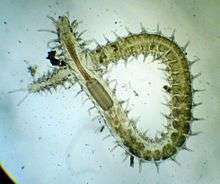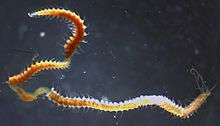Syllidae
Syllidae is a family of small to medium-sized polychaete worms. Syllids are distinguished from other polychaetes by the presence of a muscular region of the anterior digestive tract known as the proventricle.[2]
| Syllidae | |
|---|---|
 | |
| Syllis gracilis micrograph, showing the distinctive barrel-shaped proventricle | |
| Scientific classification | |
| Kingdom: | Animalia |
| Phylum: | Annelida |
| Class: | Polychaeta |
| Order: | Phyllodocida |
| Family: | Syllidae Grube 1850[1] |

Syllid worms range in size from 2–3 mm (0.08–0.12 in) to 14 centimetres (5.5 in). Most syllids are benthic organisms that transition to a pelagic epitoke for reproduction. They are found in all regions of the ocean, from the intertidal zone to the deep sea, and are especially abundant in shallow water.[2][3]
They are found in a range of habitats, moving actively on rock and sandy substrates, hiding in crevices and among seaweeds, and climbing on sponges, corals, hydrozoans, seagrasses and mangroves. They are generalist feeders.[4]
One species in the family, Syllis ramosa, was the first polychaete discovered to have a branching body plan.[5]
Subfamilies
- Anoplosyllinae
- Autolytinae
- Eusyllinae
- Exogoninae
- Syllinae
References
- Gil, J., Musco, L. (2015). Read G, Fauchald K (eds.). "Syllidae Grube, 1850". World Polychaeta database. World Register of Marine Species. Retrieved 16 September 2017.
- Fukuda, Marcelo V. "Syllidae". Encyclopedia of Life. Retrieved 16 September 2017.
- San Martín, Guillermo; Worsfold, Tim M. (2015). "Guide and keys for the identification of Syllidae (Annelida, Phyllodocida) from the British Isles (reported and expected species)". ZooKeys (488). pp. 1–29. doi:10.3897/zookeys.488.9061. PMC 4389122.
- Sigvaldadottir, Elin; Mackie, Andrew S.Y.; Helgason, Gudmundur V.; Reish, Donald J.; Svavarsson, Jorundur; Steingrimsson, Sigmar A.; Gudmundsson, Gudmundur (2013). Advances in Polychaete Research. Springer Science & Business Media. p. 288. ISBN 978-94-017-0655-1.
- Marshall, Michael (2 March 2012). "Zoologger: the worm that looks like a tree". New Scientist. Retrieved 28 September 2017.
| Wikimedia Commons has media related to Syllidae. |